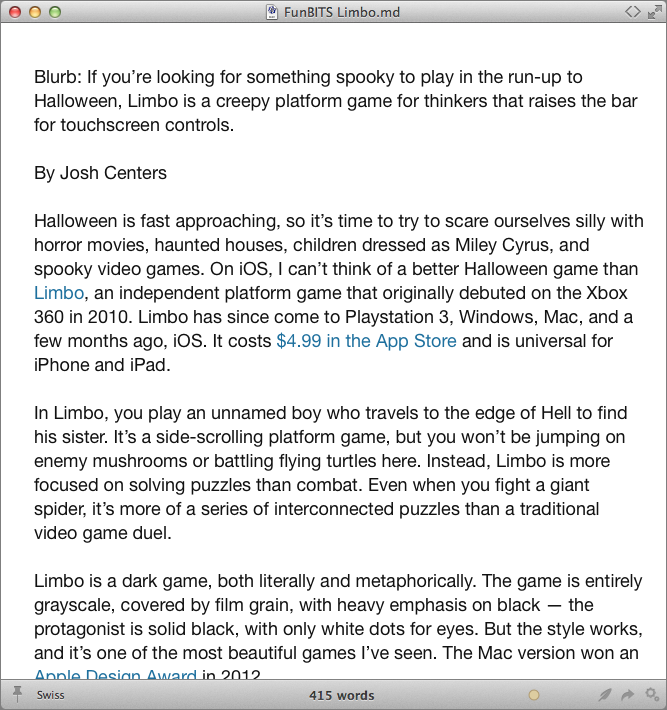- Marked 2 4 11 – Easily Preview Your Markdown Documents Pdf
- Marked 2 4 11 – Easily Preview Your Markdown Documents Automatically
- Marked 2 4 11 – Easily Preview Your Markdown Documents Free
- Marked 2 4 11 – Easily Preview Your Markdown Documents Electronically
3.7 Markdown document
The perfect preview tool for Markdown is Marked 2 which gives a preview of your Markdown and watches the file so that every time you save in an editor your preview is updated. It also supports custom pre-processors so you can use extra markup such as critic, custom CSS so you can have a preview that looks however you wish and tools to export the result in a variety of formats. Marked Custom Styles. A collection of custom styles available for Marked 2. Have your own and want to share? Use the Custom Style Uploader to submit for review. If you're browsing on a Mac with Marked 2 installed, you can click the Install button on any style to instantly add it to Marked. If you'd rather install manually, just use the CSS link to save the style to disk, then use the Custom. Drag any Markdown-formatted document (or, again, a text, HTML, or MultiMarkdown document) onto the Marked icon in the Finder or the Dock, and Marked opens a window showing a preview of what that.
Marked allows you to preview your Markdown (in any flavor) as you write in your favorite text editor. It tracks your file changes and updates the preview as you go, even automatically scrolling to the point in the file where you're currently working. Marked 2 includes a. A lot of good answers given here already. But if you need some more flexibility in your Markdown preview than most lightweight previewers provide — and you don't mind paying for software — I can easily recommend Marked 2.It integrates into Vim using the vim-marked plugin. Edit: It was even once recommended by the creator of Markdown.
In some cases, you might want to produce plain Markdown output from R Markdown (e.g., to create a document for a system that accepts Markdown input like Stack Overflow).
To create a Markdown document from R Markdown, you specify the md_document output format in the front-matter of your document:
3.7.1 Markdown variants
By default, the md_document format produces 'strict' Markdown (i.e., conforming to the original Markdown specification with no extensions). You can generate a different flavor of Markdown using the variant option. For example:


Valid values are:
markdown(Full Pandoc Markdown)markdown_strict(Original Markdown specification; the default)markdown_github(GitHub Flavored Markdown)markdown_mmd(MultiMarkdown)markdown_phpextra(PHP Markdown extra)
You can also compose custom Markdown variants. For example:
See Pandoc's Manual for all of the Markdown extensions and their names to be used in composing custom variants.
Marked 2 4 11 – Easily Preview Your Markdown Documents Pdf
3.7.1.1 Publishing formats
Many popular publishing systems now accept Markdown as input. Table 3.5 shows the correct Markdown variants to use for some popular systems.
Marked 2 4 11 – Easily Preview Your Markdown Documents Automatically
| System | Markdown Variant |
|---|---|
| GitHub Wikis | markdown_github |
| Drupal | markdown_phpextra |
| WordPress.com | markdown_phpextra+backtick_code_blocks |
| StackOverflow | markdown_strict+autolink_bare_uris |
Marked 2 4 11 – Easily Preview Your Markdown Documents Free
In many cases, you can simply copy and paste the Markdown generated by rmarkdown::render() into the editing interface of the system you are targeting. Note, however, that if you have embedded plots or other images, you will need to upload them separately and fix up their URLs to point to the uploaded location. If you intend to build websites based on R Markdown, we recommend that you use the more straightforward solutions such as blogdown(Xie, Hill, and Thomas 2017; Xie 2020a) as introduced in Section 10 instead of manually copying the Markdown content.
3.7.2 Other features
Marked 2 4 11 – Easily Preview Your Markdown Documents Electronically
Refer to Section 3.1 for the documentation of other features of Markdown documents, including table of contents (Section 3.1.1), figure options (Section 3.1.5), header and before/after body inclusions (Section 3.1.10.2), Pandoc arguments (Section 3.1.10.5), and shared options (Section 3.1.11).
